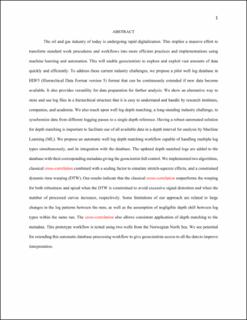| dc.contributor.author | Torres Caceres, Veronica Alejandra | |
| dc.contributor.author | Duffaut, Kenneth | |
| dc.contributor.author | Westad, Frank Ove | |
| dc.contributor.author | Stovas, Alexey | |
| dc.contributor.author | Johansen, Yngve Bolstad | |
| dc.contributor.author | Jenssen, Arne Johannes Kaaijk | |
| dc.date.accessioned | 2022-03-29T10:32:49Z | |
| dc.date.available | 2022-03-29T10:32:49Z | |
| dc.date.created | 2022-01-11T22:02:40Z | |
| dc.date.issued | 2022 | |
| dc.identifier.citation | Petrophysics. 2022, 63 (1), 1-26. | en_US |
| dc.identifier.issn | 1529-9074 | |
| dc.identifier.uri | https://hdl.handle.net/11250/2988259 | |
| dc.description.abstract | The oil and gas industry of today is undergoing rapid digitalization. This implies a massive effort to transform standard work procedures and workflows into more efficient practices and implementations using machine learning and automation. This will enable geoscientists to explore and exploit vast amounts of data quickly and efficiently. To address these current industry challenges, we propose a pilot well log database in HDF5 (Hierarchical Data Format version 5) format that can be continuously extended if new data become available. It also provides versatility for data preparation for further analysis. We show an alternative way to store and use log files in a hierarchical structure that it is easy to understand and handle by research institutes, companies, and academia. We also touch upon well log depth matching, a long-standing industry challenge, to synchronize data from different logging passes to a single depth reference. Having a robust automated solution for depth matching is important to facilitate use of all available data in a depth interval for analysis by Machine Learning (ML). We propose an automatic well log depth matching workflow capable of handling multiple log types simultaneously, and its integration with the database. The updated depth matched logs are added to the database with their corresponding metadata giving the geoscientist full control. We implemented two algorithms, classical cross-correlation combined with a scaling factor to simulate stretch-squeeze effects, and a constrained dynamic time warping (DTW). Our results indicate that the classical cross-correlation outperforms the warping for both robustness and speed when the DTW is constrained to avoid excessive signal distortion and when the number of processed curves increases, respectively. Some limitations of our approach are related to large changes in the log patterns between the runs, as well as the assumption of negligible depth shift between log types within the same run. The cross-correlation also allows consistent application of depth matching to the metadata. This prototype workflow is tested using two wells from the Norwegian North Sea. We see potential for extending this automatic database-processing workflow to give geoscientists access to all the data to improve interpretation. | en_US |
| dc.language.iso | eng | en_US |
| dc.publisher | OnePetro | en_US |
| dc.title | Automated Log Data Analytics Workflow – The Value of Data Access and Management to Reduced Turnaround Time for Log Analysis | en_US |
| dc.type | Peer reviewed | en_US |
| dc.type | Journal article | en_US |
| dc.description.version | acceptedVersion | en_US |
| dc.rights.holder | This is the authors' accepted manuscript to an article published by OnePetro. | en_US |
| dc.source.pagenumber | 1-26 | en_US |
| dc.source.volume | 63 | en_US |
| dc.source.journal | Petrophysics | en_US |
| dc.source.issue | 1 | en_US |
| dc.identifier.doi | 10.30632/PJV63N1-2022a3 | |
| dc.identifier.cristin | 1978926 | |
| dc.relation.project | Norges teknisk-naturvitenskapelige universitet: BRU21-NTNU | en_US |
| cristin.ispublished | true | |
| cristin.fulltext | postprint | |
| cristin.qualitycode | 1 | |
